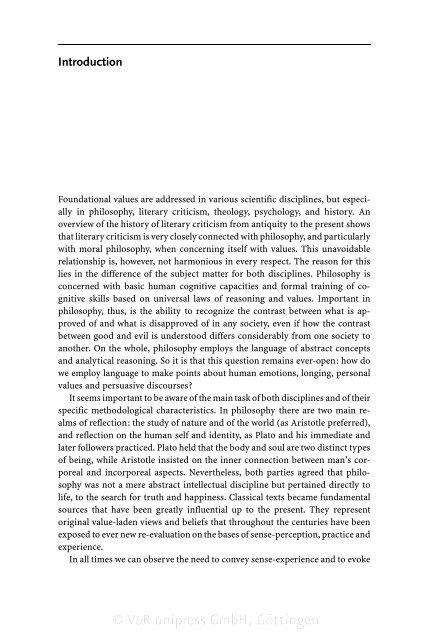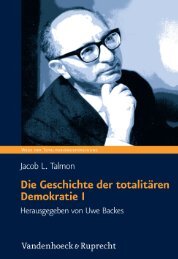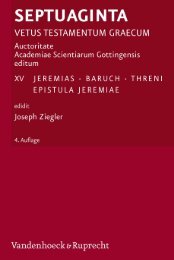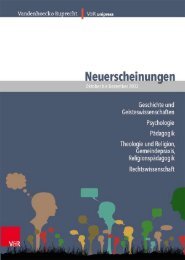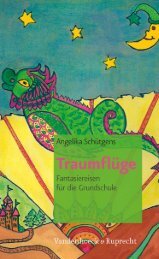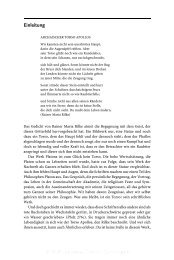Reality and Truth in Literature
Reality and Truth in Literature
Reality and Truth in Literature
Create successful ePaper yourself
Turn your PDF publications into a flip-book with our unique Google optimized e-Paper software.
Introduction<br />
Foundational values are addressed <strong>in</strong> various scientific discipl<strong>in</strong>es, but especially<br />
<strong>in</strong> philosophy, literary criticism, theology, psychology, <strong>and</strong> history. An<br />
overview of the history of literary criticism from antiquity to the present shows<br />
that literary criticism is very closely connected with philosophy, <strong>and</strong> particularly<br />
with moral philosophy, when concern<strong>in</strong>g itself with values. This unavoidable<br />
relationship is, however, not harmonious <strong>in</strong> every respect. The reason for this<br />
lies <strong>in</strong> the difference of the subject matter for both discipl<strong>in</strong>es. Philosophy is<br />
concerned with basic human cognitive capacities <strong>and</strong> formal tra<strong>in</strong><strong>in</strong>g of cognitive<br />
skills based on universal laws of reason<strong>in</strong>g <strong>and</strong> values. Important <strong>in</strong><br />
philosophy, thus, is the ability to recognize the contrast between what is approved<br />
of <strong>and</strong> what is disapproved of <strong>in</strong> any society, even if how the contrast<br />
between good <strong>and</strong> evil is understood differs considerably from one society to<br />
another. On the whole, philosophy employs the language of abstract concepts<br />
<strong>and</strong> analytical reason<strong>in</strong>g. So it is that this question rema<strong>in</strong>s ever-open: how do<br />
we employ language to make po<strong>in</strong>ts about human emotions, long<strong>in</strong>g, personal<br />
values <strong>and</strong> persuasive discourses?<br />
It seems important to be aware of the ma<strong>in</strong> task of both discipl<strong>in</strong>es <strong>and</strong> of their<br />
specific methodological characteristics. In philosophy there are two ma<strong>in</strong> realms<br />
of reflection: the study of nature <strong>and</strong> of the world (as Aristotle preferred),<br />
<strong>and</strong> reflection on the human self <strong>and</strong> identity, as Plato <strong>and</strong> his immediate <strong>and</strong><br />
later followers practiced. Plato held that the body <strong>and</strong> soul are two dist<strong>in</strong>ct types<br />
of be<strong>in</strong>g, while Aristotle <strong>in</strong>sisted on the <strong>in</strong>ner connection between man’s corporeal<br />
<strong>and</strong> <strong>in</strong>corporeal aspects. Nevertheless, both parties agreed that philosophy<br />
was not a mere abstract <strong>in</strong>tellectual discipl<strong>in</strong>e but perta<strong>in</strong>ed directly to<br />
life, to the search for truth <strong>and</strong> happ<strong>in</strong>ess. Classical texts became fundamental<br />
sources that have been greatly <strong>in</strong>fluential up to the present. They represent<br />
orig<strong>in</strong>al value-laden views <strong>and</strong> beliefs that throughout the centuries have been<br />
exposed to ever new re-evaluation on the bases of sense-perception, practice <strong>and</strong><br />
experience.<br />
In all times we can observe the need to convey sense-experience <strong>and</strong> to evoke
20<br />
Introduction<br />
ethical reflection by us<strong>in</strong>g a more suitable mode of expression, one that has an<br />
eye to the larger structures of literary presentation of reality <strong>and</strong> truth. <strong>Literature</strong><br />
deals with presentation of life <strong>in</strong> all its contrast<strong>in</strong>g manifestations <strong>in</strong> persuasive<br />
literary forms <strong>and</strong> is therefore <strong>in</strong>tr<strong>in</strong>sically connected with aesthetics. Ethical<br />
sensibility, meanwhile, is most effective when deal<strong>in</strong>g with particular <strong>in</strong>dividuals<br />
<strong>in</strong> specific contexts. Characters that embody goodness <strong>and</strong> love can be<br />
identified with beauty of soul. Evaluation of characters <strong>in</strong> specific contexts<br />
manifests an <strong>in</strong>ner relationship between foundational values <strong>and</strong> aesthetics.<br />
Works of literature comb<strong>in</strong>e the particular <strong>and</strong> the general <strong>in</strong> concrete life situations<br />
<strong>and</strong> <strong>in</strong> <strong>in</strong>dividual characters. Acceptance of reality, especially of <strong>in</strong>dividual<br />
persons, opens the way to love, <strong>and</strong> yet acceptance <strong>and</strong> love are not<br />
possible without beauty.<br />
It is agreed <strong>in</strong> both philosophy <strong>and</strong> literary criticism that values like truth,<br />
beauty <strong>and</strong> love are, <strong>in</strong> their extended semantic field, closely related. It is also<br />
agreed that the methodological possibilities <strong>in</strong> philosophy <strong>and</strong> literary criticism<br />
for grasp<strong>in</strong>g <strong>and</strong> expla<strong>in</strong><strong>in</strong>g this relationship are not the same as <strong>in</strong> the realm of<br />
literature itself. <strong>Literature</strong> uses language as a system of metaphors while concern<strong>in</strong>g<br />
itself with literary context <strong>and</strong> literary structures. The power of persuasion<br />
<strong>and</strong> synthetic perception of life has been especially ably evaluated by<br />
those great writers of all times who also wrote essays on the nature of literature<br />
<strong>and</strong> proved that their underst<strong>and</strong><strong>in</strong>g of values <strong>and</strong> of literary forms seem fitted<br />
for one another. The <strong>in</strong>terplay between foundational values <strong>and</strong> literary style<br />
functions <strong>in</strong> <strong>in</strong>terpenetrat<strong>in</strong>g ways. This universally recognized fact calls for new<br />
methods <strong>and</strong> styles <strong>in</strong> deal<strong>in</strong>g with literary <strong>in</strong> the totality of its complex <strong>and</strong><br />
dramatic structure, while devot<strong>in</strong>g full attention to both <strong>in</strong>dividual context <strong>and</strong><br />
to the <strong>in</strong>teraction between character <strong>and</strong> conduct.<br />
Poetry <strong>and</strong> narratives such as short stories <strong>and</strong> novels are expressly designed,<br />
accord<strong>in</strong>g to aesthetic criteria, for our delight <strong>and</strong> exploration. Literary works<br />
put not just values but also emotions <strong>and</strong> models of life on display. Technical<br />
analysis of literary texts may beg<strong>in</strong> with simple reflection on common experience<br />
<strong>and</strong> values. Analysis of literary texts h<strong>in</strong>ges on basic human cognitive<br />
capacities <strong>and</strong> a widespread potential for foster<strong>in</strong>g <strong>in</strong>novation <strong>in</strong> openness to<br />
alternative views. As Col<strong>in</strong> McG<strong>in</strong>n states, “One of the reasons we are drawn to<br />
fictional works is precisely that they comb<strong>in</strong>e the particular <strong>and</strong> the general <strong>in</strong><br />
ways we f<strong>in</strong>d natural <strong>and</strong> <strong>in</strong>telligible. The general is woven <strong>in</strong>to the particular,<br />
which gives the particular significance <strong>and</strong> the general substance” (McG<strong>in</strong>n<br />
2007: 3). The figurative nature of literary discourse allows us to consider thematic<br />
<strong>and</strong> aesthetic commonalities <strong>and</strong> <strong>in</strong>terrelations from <strong>in</strong>terdiscipl<strong>in</strong>ary <strong>and</strong><br />
<strong>in</strong>tercultural perspectives. Orig<strong>in</strong>al <strong>and</strong> aesthetically pleas<strong>in</strong>g literary styles<br />
encourage <strong>in</strong>novative methods, practices <strong>and</strong> especially doctr<strong>in</strong>es <strong>and</strong> theories.<br />
In deal<strong>in</strong>g with the question of the criteria <strong>in</strong>voked when judg<strong>in</strong>g what is beau-
Introduction 21<br />
tiful <strong>in</strong> the cross-cultural application of the notion of art, Geoffrey Ernest Richard<br />
Lloyd notes: “My argument has been that such ‘commonalities’ as we can<br />
discern are to be found at a deeper level. Some recognition of some dist<strong>in</strong>ction<br />
between the attractive <strong>and</strong> the ugly, the ref<strong>in</strong>ed <strong>and</strong> the coarse, the admirable <strong>and</strong><br />
the dull, is common, if not universal. That po<strong>in</strong>t rema<strong>in</strong>s however much we differ<br />
<strong>in</strong> what we admire <strong>and</strong> <strong>in</strong> how we might go about expla<strong>in</strong><strong>in</strong>g our preferences if<br />
<strong>in</strong>deed we th<strong>in</strong>k they need some justification” (Lloyd 2009: 109).<br />
S<strong>in</strong>ce antiquity literature has been considered a particular k<strong>in</strong>d of imitation<br />
(mímesis). Friedrich Schiller dist<strong>in</strong>guished between imitation of nature <strong>and</strong><br />
imitation of human emotion (Schiller 1981). Imitation of nature is the subject of<br />
naïve art, whereas imitation of human emotion is the subject of sentimental art.<br />
Both types of literature comb<strong>in</strong>e an analytical <strong>and</strong> a synthetic way of presentation,<br />
<strong>and</strong> both tend also to consider tradition while nevertheless rema<strong>in</strong><strong>in</strong>g<br />
open to <strong>in</strong>novation. This, however, is true of all sciences, cultures <strong>and</strong> religions.<br />
Grasp<strong>in</strong>g reality <strong>in</strong> its totality is therefore the first methodological pr<strong>in</strong>ciple of<br />
the study. A “total approach” on existential grounds conveys an awareness of the<br />
<strong>in</strong>ner connection of all foundational values, of the <strong>in</strong>ner connection between<br />
aesthetics <strong>and</strong> ethics <strong>and</strong> of the way to make an educational impact by means of<br />
persuasion. A “total approach” also favours an <strong>in</strong>terdiscipl<strong>in</strong>ary orientation of<br />
research on the basis of analogy between material <strong>and</strong> spiritual reality.<br />
Certa<strong>in</strong> basic themes <strong>and</strong> forms are present <strong>in</strong> the literature of all times <strong>and</strong><br />
cultures. A comparative treatment of literary texts is a path to discover<strong>in</strong>g the<br />
contrast<strong>in</strong>g relation of similarities <strong>and</strong> differences between authors, cultures <strong>and</strong><br />
periods. Some foundational values were adopted <strong>in</strong> Europe from ancient Greece<br />
<strong>and</strong> Rome, <strong>and</strong> some from the ancient Middle East <strong>and</strong> Israel. One pair of<br />
common themes is long<strong>in</strong>g <strong>and</strong> temptation (Avsenik Nabergoj 2009 <strong>and</strong> 2010),<br />
<strong>and</strong> <strong>in</strong> this regard Judaism, Christianity <strong>and</strong> Islam share a common heritage of<br />
biblical sources (Kvam et al. 1999; Volf et al. 2010). Intercultural <strong>and</strong> <strong>in</strong>terreligious<br />
dialogue challenges abstract doctr<strong>in</strong>es <strong>and</strong> the comm<strong>and</strong>ment style of<br />
moral discourse, while stok<strong>in</strong>g the imag<strong>in</strong>ation, common sense-perception <strong>and</strong><br />
experience by rais<strong>in</strong>g fundamental questions about humans – about men <strong>and</strong><br />
women – <strong>and</strong> society.<br />
Comparative literary analysis has the potential to effect positive changes <strong>in</strong><br />
relations between representatives of various cultures <strong>and</strong> faiths. Shared experience<br />
<strong>and</strong> knowledge can transform engaged <strong>in</strong>dividuals from <strong>in</strong>effective observers<br />
<strong>in</strong>to seekers of truth, beauty <strong>and</strong> love. Liv<strong>in</strong>g examples – for <strong>in</strong>stance<br />
those timeless icons of nonviolence, Mahatma G<strong>and</strong>hi, Mart<strong>in</strong> Luther K<strong>in</strong>g, <strong>and</strong><br />
Nelson M<strong>and</strong>ela – emerged from the belief that shared experience <strong>and</strong> knowledge<br />
can create a common ground with<strong>in</strong> the global world <strong>and</strong> thus make last<strong>in</strong>g<br />
contributions to a glorification of the <strong>in</strong>nate goodness <strong>in</strong> humans. Only great<br />
souls can <strong>in</strong>spire people of all races, backgrounds <strong>and</strong> religions to turn anger
22<br />
Introduction<br />
<strong>in</strong>to compassion, hatred <strong>in</strong>to love. <strong>Literature</strong> shows that throughout history all<br />
last<strong>in</strong>g relationships <strong>and</strong> all communities have been built on the path of life <strong>and</strong><br />
on personal relationships embrac<strong>in</strong>g truth, beauty <strong>and</strong> love. Employ<strong>in</strong>g a “total<br />
approach” <strong>in</strong> comparative literary research is a means of putt<strong>in</strong>g love to work <strong>in</strong><br />
resolv<strong>in</strong>g problems, heal<strong>in</strong>g relationships <strong>and</strong> creat<strong>in</strong>g last<strong>in</strong>g peace. In the f<strong>in</strong>al<br />
analysis it is clear that the sense of truth, beauty <strong>and</strong> love is not only <strong>in</strong>spiration<br />
but also a skill <strong>in</strong> perceiv<strong>in</strong>g values on the basis of experience.<br />
An exam<strong>in</strong>ation of contemporary writ<strong>in</strong>g on literary theory <strong>and</strong> especially<br />
literary genres reveals great plurality, or even confusion, <strong>in</strong> both the use of<br />
term<strong>in</strong>ology for fundamental classification <strong>in</strong>to literary types <strong>and</strong> genres <strong>and</strong> <strong>in</strong><br />
determ<strong>in</strong><strong>in</strong>g the criteria for describ<strong>in</strong>g them. In his Poetics Aristotle provided,<br />
without prescrib<strong>in</strong>g any rules, the fundamental theory of literary types through<br />
his description of the conventions govern<strong>in</strong>g <strong>in</strong>dividual types or genres. In<br />
general, s<strong>in</strong>ce antiquity literary theorists have offered normative descriptions of<br />
literary types <strong>and</strong> genres <strong>in</strong> the framework of a system that allows for a relatively<br />
reliable classification of types of literature <strong>in</strong>to correspond<strong>in</strong>g literary genres.<br />
Johann Wolfgang von Goethe spoke of the three ma<strong>in</strong> types or “natural forms of<br />
poetry” (the epic, the lyric, <strong>and</strong> the dramatic). This basic division <strong>and</strong> traditional<br />
classificatory system was later questioned as an open system of literary types <strong>and</strong><br />
genres was put forth. Because the l<strong>in</strong>es between the types <strong>and</strong> genres are no<br />
longer so firmly drawn, there is little certa<strong>in</strong>ty when it comes to ascrib<strong>in</strong>g texts to<br />
a particular category – that is, to know<strong>in</strong>g where to place texts that have characteristics<br />
of more than one type or genre. In both a theoretical <strong>and</strong> practical<br />
perspective it is of fundamental importance that the criteria for classify<strong>in</strong>g<br />
literary types <strong>and</strong> their description be determ<strong>in</strong>ed. Some critics have attempted<br />
to classify literary types <strong>and</strong> genres, though <strong>in</strong> so do<strong>in</strong>g they have run <strong>in</strong>to the<br />
dilemma of whether to do this accord<strong>in</strong>g to formal characteristics or accord<strong>in</strong>g<br />
to content. Attempts to answer this question led to the prevail<strong>in</strong>g pr<strong>in</strong>ciple of<br />
pluralism <strong>in</strong> lay<strong>in</strong>g out the relevant criteria. Attempts to determ<strong>in</strong>e criteria,<br />
meanwhile, show that the greatest dynamic exists <strong>in</strong> reflect<strong>in</strong>g on <strong>and</strong> search<strong>in</strong>g<br />
for an answer to these unanswered questions about the relation between the<br />
theory of literary genres <strong>and</strong> the history of literary genres. The criteria can be<br />
worked out only by means of theory, but that necessarily <strong>in</strong>cludes critically<br />
evaluat<strong>in</strong>g the history of creat<strong>in</strong>g <strong>and</strong> def<strong>in</strong><strong>in</strong>g literary types <strong>and</strong> genres.<br />
Literary types <strong>and</strong> genres represent different artistic ways of writ<strong>in</strong>g about<br />
various views of reality <strong>in</strong> the material world, <strong>in</strong> society <strong>and</strong> <strong>in</strong> life <strong>in</strong> general, as<br />
well as about the truth of even the subtlest shades of the psychological <strong>and</strong><br />
spiritual state of heroes. It is for this reason that the most important question for<br />
the reader of a literary work perta<strong>in</strong>s to the multi-layered relation between form<br />
<strong>and</strong> content. An organic <strong>in</strong>terweav<strong>in</strong>g of form <strong>and</strong> content occurs already <strong>in</strong> the<br />
very com<strong>in</strong>g-<strong>in</strong>to-be<strong>in</strong>g of literary works. <strong>Literature</strong> is an answer to the chall-
Introduction 23<br />
enges of environment, <strong>in</strong>terpersonal relations, social relations, <strong>and</strong> historical<br />
occurrences. <strong>Literature</strong> is a synthetic <strong>and</strong> artistic response to the challenges of<br />
time <strong>and</strong> space <strong>in</strong> the rhythm of life. Literary types <strong>and</strong> genres, thus, do not<br />
merely emerge of themselves. They are, rather, a consequence of expectations<br />
that arise <strong>in</strong> social constellations, <strong>in</strong> <strong>in</strong>dividual life stories, <strong>and</strong> <strong>in</strong> the vision <strong>and</strong><br />
plann<strong>in</strong>g of the future.<br />
Modern mus<strong>in</strong>gs on the relation between form <strong>and</strong> content <strong>in</strong> literature have<br />
seen an <strong>in</strong>creas<strong>in</strong>g awareness of historical memory <strong>and</strong> of life experience. Both<br />
factors occupy such a fundamentally creative <strong>and</strong> cognitive role <strong>in</strong> the life of man<br />
as an <strong>in</strong>dividual <strong>and</strong> of society as a whole that some literary theorists value<br />
literary works as both a collective found<strong>in</strong>g document <strong>and</strong> recognizable marker<br />
of the memory of <strong>in</strong>dividuals <strong>and</strong> entire societies of a culture. One need only<br />
consider the role of literary works that have entered the canon of a particular<br />
nation or even of the <strong>in</strong>ternational community. The more important the role a<br />
literary work assumes <strong>in</strong> terms of cultural memory, the more it becomes a part of<br />
the context for the production of new texts. In other words, the more it becomes<br />
part of an organic process of <strong>in</strong>tertextual communication both with<strong>in</strong> a particular<br />
culture <strong>and</strong> <strong>in</strong> <strong>in</strong>tercultural dialogue; it even establishes its position <strong>in</strong> the<br />
process of <strong>in</strong>terculturality. This is why literature evidently has a more important<br />
role <strong>in</strong> the cognitive <strong>and</strong> the educational process at the level of <strong>in</strong>dividuals <strong>and</strong> of<br />
society than may seem to be the case given entirely divergent views on the role of<br />
literature.<br />
Of course we could not speak of “cultural memory” if literature did not grow<br />
from impulses of primal human experience that span the polarity between<br />
long<strong>in</strong>g <strong>and</strong> despair, love <strong>and</strong> hatred, war <strong>and</strong> peace. If the wisdom writer <strong>in</strong> the<br />
book of Ecclesiastes (3:1 – 8) sets down his experience by not<strong>in</strong>g that “To every<br />
th<strong>in</strong>g there is a season” <strong>and</strong> encompasses all the fundamental experiences, he is<br />
speak<strong>in</strong>g while aware of the unfathomable strength of the laws of the universe,<br />
the environment of life, <strong>and</strong> the impulses of human <strong>in</strong>nerness that affect man’s<br />
manner of feel<strong>in</strong>g, th<strong>in</strong>k<strong>in</strong>g, his life <strong>and</strong> his creat<strong>in</strong>g. Literary works, with their<br />
generic <strong>and</strong> specific formal elements, are the central elements of our memory<br />
because they express the experience of past generations so truthfully that new<br />
generations can uncover <strong>in</strong> them the reality <strong>and</strong> truth of their life <strong>and</strong> can<br />
identify with their message. It is on the basis of this that literary types <strong>and</strong> genres<br />
represent models of <strong>in</strong>terpretation of life experience <strong>and</strong> that they can also<br />
become a part of the canon of the human community that encodes values <strong>and</strong><br />
norms on the basis of time-honoured experiences of human history.<br />
The first part of this monograph is the fruit of a lengthy search for an answer<br />
to the question of where the explanations lie for the widespread <strong>and</strong> un<strong>in</strong>terrupted<br />
contemporis<strong>in</strong>g of literature <strong>in</strong> various literary genres as well as <strong>in</strong> folk<br />
<strong>and</strong> artistic representations the world over. In their studies, renowned writers
24<br />
Introduction<br />
who have also contributed to literary theory express – sometimes more, sometimes<br />
less overtly – their recognition that ultimately literature is an artistic<br />
embodiment of what we have experienced <strong>in</strong> light of facts (which are also an area<br />
of empirical science), <strong>and</strong> under the impression of the convictions which generally<br />
reign <strong>in</strong> a community <strong>and</strong> which historical experience also confirms. In<br />
Chapter 9 of his Poetics, Aristotle summed up the criteria of poetic reality <strong>and</strong><br />
truth: “it is not the function of the poet to relate what has happened, but what<br />
may happen – what is possible accord<strong>in</strong>g to the law of probability or necessity”<br />
(1451b). No literary theory could seriously question this statement. The art of<br />
writ<strong>in</strong>g with<strong>in</strong> a system or “canon” of literary types is thus an echo of the<br />
<strong>in</strong>ternal necessity or lawfulness of natural phenomena <strong>and</strong> phenomena of life<br />
which is endowed with reason <strong>and</strong> is <strong>in</strong>cl<strong>in</strong>ed to truth.<br />
Exam<strong>in</strong><strong>in</strong>g the roots <strong>and</strong> development of literary types <strong>and</strong> genres allows for<br />
profound <strong>in</strong>sight <strong>in</strong>to the many possibilities that exist for creative literary<br />
communication <strong>in</strong> terms of content. Though the broadest realm is the structure<br />
of the universe, which we measure <strong>in</strong> light years, we also present, <strong>in</strong> ever contrast<strong>in</strong>g<br />
shades, our immediate life surround<strong>in</strong>gs. That is why nature, s<strong>in</strong>ce the<br />
very beg<strong>in</strong>n<strong>in</strong>g of human consciousness <strong>and</strong> imag<strong>in</strong>ation, has served as the<br />
source of <strong>in</strong>numerable models for imitation (mímesis) <strong>in</strong> all areas of artistic<br />
creativity. It was on the basis of this that primal literary forms – that is, literary<br />
types – arose, <strong>and</strong> that the first “collections” <strong>in</strong> the oral tradition tightly l<strong>in</strong>ked<br />
family members <strong>and</strong> the broader human community. Various literary types <strong>and</strong><br />
forms came <strong>in</strong>to be<strong>in</strong>g spontaneously – after the rise of literacy, the first literary<br />
theories were born <strong>and</strong> these theories more or less <strong>in</strong>fluenced the cont<strong>in</strong>ued <strong>and</strong><br />
lengthy development of the literary process. Observations of nature prompted<br />
both artistic creativity <strong>and</strong> scientific <strong>in</strong>vestigation, <strong>and</strong> analysis <strong>and</strong> synthesis<br />
were determ<strong>in</strong><strong>in</strong>g factors for the rise of various types of arts <strong>and</strong> sciences.<br />
S<strong>in</strong>ce nature has always been the basic model for imitation, it has, simultaneously,<br />
also been the basis of the criteria for judg<strong>in</strong>g truth <strong>and</strong>, accord<strong>in</strong>gly,<br />
objective reality. The human spirit shone also <strong>in</strong> the search<strong>in</strong>g for a common<br />
core with<strong>in</strong> the myriad phenomena <strong>in</strong> the material world. Already <strong>in</strong> ancient<br />
times people began to unveil the work<strong>in</strong>gs of natural law, <strong>and</strong> so it was that<br />
natural law later also entered consciousness as a concept. The poet <strong>and</strong> the<br />
scientist co-existed <strong>and</strong> co-created <strong>in</strong> harmony, as each was seek<strong>in</strong>g the common<br />
core of the phenomenal world, each <strong>in</strong> his own way. The polymath Goethe is<br />
among the lead<strong>in</strong>g spokesmen for the harmony between external <strong>and</strong> <strong>in</strong>ternal<br />
order <strong>in</strong> man’s underst<strong>and</strong><strong>in</strong>g of truth.<br />
The creative imitat<strong>in</strong>g of the reality of the material world could not content<br />
itself solely with objective reality of the appearance of nature; rather, it necessarily<br />
<strong>in</strong>cluded also subjective experienc<strong>in</strong>g of the world, especially man’s own<br />
experienc<strong>in</strong>g of objective reality. Man thus became the focal po<strong>in</strong>t for observ<strong>in</strong>g
Introduction 25<br />
<strong>and</strong> imitat<strong>in</strong>g. Artists tried the most suitable means of record<strong>in</strong>g the appearance<br />
of humans’ characteristics <strong>and</strong> their countless life situations at both the personal<br />
<strong>and</strong> social levels. All of this occurred of course <strong>in</strong> natural surround<strong>in</strong>gs, that is, <strong>in</strong><br />
the surround<strong>in</strong>gs of the material world. For this reason, the concordance between<br />
the conceiv<strong>in</strong>g of external <strong>and</strong> <strong>in</strong>ternal reality became a crucial issue <strong>and</strong><br />
the central problem <strong>in</strong> artistic creation. In Maxim 533, Goethe remarks, “Ord<strong>in</strong>ary<br />
view<strong>in</strong>g, a right conception of earthly matters, is the heritage of general<br />
human reason; pure view<strong>in</strong>g of what is external <strong>and</strong> <strong>in</strong>ternal is very rare.” This<br />
statement also corresponds to the organic coalescence between form <strong>and</strong> content<br />
<strong>in</strong> every artistic type <strong>and</strong> genre. Of this, Goethe states <strong>in</strong> Maxim 1351,<br />
“Perfect artists are more <strong>in</strong>debted to teach<strong>in</strong>g than to nature.” Maxim 1119 also<br />
po<strong>in</strong>ts <strong>in</strong> the same direction: “‘Creat<strong>in</strong>g out of oneself’, as it is called, usually<br />
results <strong>in</strong> false orig<strong>in</strong>als <strong>and</strong> mannerists” (Goethe 1999).<br />
And yet all of this is scarcely the beg<strong>in</strong>n<strong>in</strong>g of the great history of art <strong>in</strong> general<br />
as well as of the genesis of literary works of various types <strong>and</strong> genres. As social<br />
life <strong>in</strong>creas<strong>in</strong>gly became the focus of art, artists <strong>in</strong>evitably began to deal with the<br />
tremendous range of man’s emotional world, his self-image, <strong>and</strong> his relation to<br />
his fellow man. And thus the realm of conceiv<strong>in</strong>g of <strong>and</strong> express<strong>in</strong>g reality<br />
exp<strong>and</strong>ed <strong>in</strong>to the conceiv<strong>in</strong>g of <strong>and</strong> express<strong>in</strong>g of truth. The discover<strong>in</strong>g of<br />
objective truth <strong>in</strong>evitably acquired a subjective character, <strong>and</strong> the ethical judgement<br />
of man’s personal <strong>and</strong> social life became central. Thus, <strong>in</strong> evaluat<strong>in</strong>g the<br />
nature <strong>and</strong> role of literature, alongside the concept of reality the essential concept<br />
of truth became a central focus. Goethe expresses this <strong>in</strong> Maxim 382: “The<br />
first <strong>and</strong> last th<strong>in</strong>g dem<strong>and</strong>ed of genius is love of truth.” In Maxim 493, meanwhile,<br />
Goethe expla<strong>in</strong>s the essential quality of truth: “To f<strong>in</strong>d <strong>and</strong> to appreciate<br />
goodness everywhere is the sign of a love of truth.” In Maxim 1220, he draws<br />
attention to the challeng<strong>in</strong>g nature of seek<strong>in</strong>g truth: “Lay<strong>in</strong>g hold of the truth<br />
dem<strong>and</strong>s a much higher approach than what is called for <strong>in</strong> defence of [error].”<br />
Maxim 78 reads, “Wisdom is to be found only <strong>in</strong> truth.”<br />
With this search<strong>in</strong>g the nature of the universal dimension did not lose validity<br />
but <strong>in</strong> fact became more valuable. The <strong>in</strong>creas<strong>in</strong>gly necessary viewpo<strong>in</strong>t of man’s<br />
creative world <strong>in</strong>to the <strong>in</strong>ternal world of the soul entailed a broaden<strong>in</strong>g of possible<br />
viewpo<strong>in</strong>ts for judg<strong>in</strong>g objective reality, <strong>and</strong> at the same time this reality<br />
became an image of or symbol for portray<strong>in</strong>g especially the <strong>in</strong>expressible shades<br />
of man’s psychology <strong>and</strong> spirituality. Art <strong>and</strong> science developed accord<strong>in</strong>g to the<br />
pr<strong>in</strong>ciple of analogy, <strong>and</strong> <strong>in</strong> the area of philosophy the concept of the “analogy of<br />
be<strong>in</strong>g” (analogia entis) appeared. It became all the more obvious that literature<br />
is an organic l<strong>in</strong>k between objective <strong>and</strong> subjective truth which could only be<br />
expressed by means of a symbol, by analogy. Literary critics speak <strong>in</strong> theoretical<br />
terms of the ambiguity of symbols, words <strong>and</strong> word cha<strong>in</strong>s, <strong>and</strong> ultimately of<br />
hermeneutic theory that exam<strong>in</strong>es the literal mean<strong>in</strong>g <strong>and</strong> the various aspects of
26<br />
Introduction<br />
metaphorical mean<strong>in</strong>g. In this lies also the reason for the tremendous significance<br />
of symbol <strong>and</strong> allegory. The essence of a symbol is that rather than offer<strong>in</strong>g<br />
an immediate way of represent<strong>in</strong>g truth it provides an analogous representation<br />
of truth. In Maxims 279 <strong>and</strong> 314, Goethe offered the follow<strong>in</strong>g, now sem<strong>in</strong>al,<br />
dist<strong>in</strong>ction between symbol <strong>and</strong> allegory :<br />
There is a great difference whether a poet is look<strong>in</strong>g for the particular that goes with the<br />
general, or sees the general <strong>in</strong> the particular. The first gives rise to allegory where the<br />
particular only counts as an example, an illustration of the particular; but the latter <strong>in</strong><br />
fact constitutes the nature of poetry, express<strong>in</strong>g someth<strong>in</strong>g particular without any<br />
thought of the general, <strong>and</strong> without <strong>in</strong>dicat<strong>in</strong>g it. Now whoever has this liv<strong>in</strong>g grasp of<br />
the particular is at the same time <strong>in</strong> possession of the general, without realiz<strong>in</strong>g it, or<br />
else only realiz<strong>in</strong>g it later on. (Maxim 279)<br />
This is true symbolism, where the particular represents the general, not as dream <strong>and</strong><br />
shadow, but as a live <strong>and</strong> immediate revelation of the unfathomable. (Maxim 314)<br />
When the organic <strong>and</strong> creative l<strong>in</strong>k<strong>in</strong>g of objective <strong>and</strong> subjective reality <strong>in</strong> art<br />
becomes the subject of analytical judgement <strong>and</strong> philosophical discourse, abstract<br />
systems <strong>in</strong>evitably follow. Systems like idealism, realism, materialism <strong>and</strong><br />
so on have little to do with reality per se. Abstract constructs, which are fabricated,<br />
become constructs that the best creators <strong>in</strong> the area of the arts as well as<br />
the sciences transcend; those who are capable of do<strong>in</strong>g so pour masses of objective<br />
reality <strong>and</strong> subjective impressions <strong>in</strong>to a created whole. Because one<br />
cannot speak of truth without ethical awareness <strong>and</strong> judgement, the terms<br />
“reality” <strong>and</strong> “truth” are not synonymous: whereas the word “reality” implies<br />
ethical neutrality, this is not the case for the word “truth.” Thus, the two concepts<br />
come simultaneously to the fore <strong>and</strong> organically supplement each other when a<br />
creative <strong>and</strong> well-mean<strong>in</strong>g <strong>in</strong>tellect is at work; they clash, however, when immaterial<br />
judg<strong>in</strong>g of one <strong>and</strong> the other occurs. <strong>Literature</strong> is the primary realm of<br />
creativity, education <strong>and</strong> scientific clarification of truth at the <strong>in</strong>dividual <strong>and</strong><br />
social levels.<br />
Emmanuel Kant’s crucial dist<strong>in</strong>ction between “pure” <strong>and</strong> “practical” reason<br />
offered contemporary <strong>and</strong> later generations of philosophers a holistic model for<br />
l<strong>in</strong>k<strong>in</strong>g objective reality <strong>and</strong> personal life experiences that <strong>in</strong>clude the moral<br />
imperative. In his Critique of Pure Reason, Kant expla<strong>in</strong>s the means of conceptual<br />
underst<strong>and</strong><strong>in</strong>g <strong>in</strong> the area of actual or possible empirical experience.<br />
When it comes to empirical experience, pure reason is especially cognizant of<br />
unit<strong>in</strong>g “the whole” <strong>and</strong> develop<strong>in</strong>g conceptual arguments for communication<br />
at both the abstract <strong>and</strong> systematic levels. This capability, however, <strong>in</strong> no way<br />
suffices or serves man’s experience <strong>in</strong> the objective world. Here man freely<br />
conceives of the moral imperative, sees dramatic ethical challenges as the basic<br />
guide for his dignity, <strong>and</strong> manifests his ethical sense of the beautiful <strong>and</strong> the
Introduction 27<br />
sublime, as well as, ultimately, his natural <strong>in</strong>cl<strong>in</strong>ation for a goal (tØlos), while<br />
sens<strong>in</strong>g absolute reality <strong>and</strong> truth. This area of human underst<strong>and</strong><strong>in</strong>g <strong>and</strong><br />
communication was dealt with by Kant <strong>in</strong> his Critique of Practical Reason. The<br />
world of nature <strong>and</strong> the world of man’s freedom are two separate entities, although<br />
they are organically <strong>in</strong>terwoven <strong>in</strong> material life. This dist<strong>in</strong>ction makes<br />
possible the discovery of the foundation of the traditional theological “negative<br />
path” (via negativa) <strong>and</strong> “negative capability,” which the poet John Keats<br />
highlighted <strong>in</strong> connection with the experience of man’s uncerta<strong>in</strong>ty, his doubts,<br />
<strong>and</strong> <strong>in</strong>capability of br<strong>in</strong>g<strong>in</strong>g his experiences about the mystical, the sublime <strong>and</strong><br />
the profound <strong>in</strong>to l<strong>in</strong>e with conceptual <strong>and</strong> systematised categories.<br />
In his sem<strong>in</strong>al book Myth, <strong>Truth</strong> <strong>and</strong> <strong>Literature</strong>: Toward a True Post-Modernism<br />
Col<strong>in</strong> Falck argues that the modern post-structuralist movement which<br />
emerged from the French literary <strong>and</strong> cultural theoriz<strong>in</strong>g of post-Saussureanism<br />
met with failure because “with its callow <strong>and</strong> philosophically <strong>in</strong>coherent antimetaphysical<br />
postur<strong>in</strong>gs, [it] has tried to disengage literature from its troublesome<br />
spiritual dimension altogether – by simply deny<strong>in</strong>g the existence of that<br />
dimension. It has thereby threatened to deprive an entire generation of students<br />
<strong>and</strong> <strong>in</strong>telligent readers a part of their spiritual birthright” (Falck: xi–xii). His<br />
evaluation of the consequence of this is<br />
students <strong>and</strong> readers are grow<strong>in</strong>g up with no real sense of the spiritual significance of<br />
literature <strong>and</strong> with no <strong>in</strong>vitation to develop their own creative sensibilities <strong>in</strong> truly<br />
literary ways. This near-death of <strong>in</strong>tuitive aesthetic sensibility <strong>in</strong> the academic world,<br />
together with the stifl<strong>in</strong>g of critical <strong>in</strong>quiry by journals with names like Critical Inquiry,<br />
the dismantl<strong>in</strong>g of the traditional literary canon for almost entirely non-literary reasons,<br />
<strong>and</strong> the virtually total supplant<strong>in</strong>g of literary discussion <strong>and</strong> criticism by culturalpolitical<br />
discussion <strong>and</strong> criticism <strong>in</strong> books <strong>and</strong> articles now written about literature,<br />
has meant that there are no longer any places <strong>in</strong> the world of organized literary education<br />
where the value of literature as an open <strong>and</strong> unprejudiced imag<strong>in</strong>ative enhancement<br />
of life can be either acknowledged or cultivated. (Falck 1994: xii)<br />
Falck does not see the solution <strong>in</strong> search<strong>in</strong>g for “new” methods but <strong>in</strong> a return to<br />
the great wealth of creative literary criticism written by writers <strong>and</strong> poets of<br />
genius. Their <strong>in</strong>sights are conv<strong>in</strong>c<strong>in</strong>g because these great m<strong>in</strong>ds were writ<strong>in</strong>g on<br />
the basis of their own creative <strong>and</strong> artistic literary experience. Though Falck<br />
po<strong>in</strong>ts especially to the great Romantic artists <strong>and</strong> literary critics, this horizon<br />
can be extended to the entirety of literary theory from antiquity to the present.<br />
The purpose of this study is thus to present such critics <strong>in</strong> a broadly diachronic<br />
<strong>and</strong> synchronic perspective.


